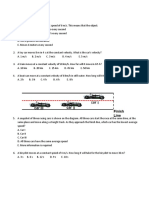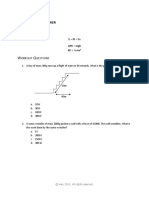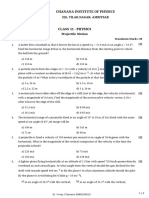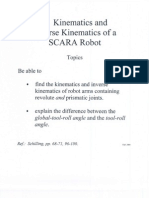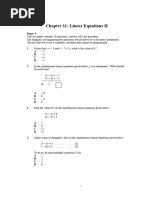Physics 1.2 Scalars and Vectors: Scalar
Uploaded by
ps_daPhysics 1.2 Scalars and Vectors: Scalar
Uploaded by
ps_daPHYSICS CHAPTER 1
1
Scalar quantity is defined as a quantity with magnitude only.
e.g. mass, time, temperature, pressure, electric current, work,
energy and etc.
Mathematics operational : ordinary algebra
Vector quantity is defined as a quantity with both magnitude &
direction.
e.g. displacement, velocity, acceleration, force, momentum,
electric field, magnetic field and etc.
Mathematics operational : vector algebra
1.2 Scalars and Vectors
PHYSICS CHAPTER 1
2
Table 1.6 shows written form (notation) of vectors.
Notation of magnitude of vectors.
1.2.1 Vectors
Vector A
Length of an arrow magnitude of vector A
displacement velocity acceleration
s
s
a v
v v =
a a =
s (bold)
v (bold) a (bold)
Direction of arrow direction of vector A
Table 1.6
PHYSICS CHAPTER 1
3
Two vectors equal if both magnitude and direction are the same.
(shown in figure 1.1)
If vector A is multiplied by a scalar quantity k
Then, vector A is
if k = +ve, the vector is in the same direction as vector A.
if k = - ve, the vector is in the opposite direction of vector A.
P
Q P
=
Figure 1.1
A k
A k
PHYSICS CHAPTER 1
4
Can be represented by using:
a) Direction of compass, i.e east, west, north, south, north-east,
north-west, south-east and south-west
b) Angle with a reference line
e.g. A man throws a stone with a velocity of 10 m s
-1
, 30 above
horizontal.
1.2.2 Direction of Vectors
30
v
x
y
0
PHYSICS CHAPTER 1
5
c) Cartesian coordinates
2-Dimension (2-D)
m) 4 m, 2 ( ) , ( = = y x s
y/m
x/m
4
2
0
PHYSICS CHAPTER 1
6
3-Dimension (3-D)
s
2
3
4
m 2) 3, 4, ( ) , , ( = = z y x s
y/m
x/m
z/m
0
PHYSICS CHAPTER 1
7
d) Polar coordinates
e) Denotes with + or signs.
( )
N,120 50 = F
F
120
+
+
-
-
PHYSICS CHAPTER 1
8
There are two methods involved in addition of vectors graphically i.e.
Parallelogram
Triangle
For example :
1.2.3 Addition of Vectors
Parallelogram Triangle
B
B A
+
O
B A
+
B
B A
+
O
PHYSICS CHAPTER 1
9
Triangle of vectors method:
a) Use a suitable scale to draw vector A.
b) From the head of vector A draw a line to represent the vector B.
c) Complete the triangle. Draw a line from the tail of vector A to the
head of vector B to represent the vector A + B.
A B B A
+ = +
Commutative Rule
B
A B
+
O
PHYSICS CHAPTER 1
10
If there are more than 2 vectors therefore
Use vector polygon and associative rule. E.g.
R Q P
+ +
R
( ) Q P
+
( ) ( ) R Q P R Q P
+ + = + +
Associative Rule
( ) R Q P
+ +
PHYSICS CHAPTER 1
11
Distributive Rule :
a.
b.
For example :
Proof of case a: let o = 2
( ) B A B A
o o o + = +
( ) A A A
| o | o + = +
number real are , | o
( ) ( ) B A B A
+ = + 2 o
B
B A
+
O
( ) B A
+ 2
PHYSICS CHAPTER 1
12
A
2
O
B
2
B A
2 2 +
( ) B A B A
2 2 2 + = +
B A B A
2 2 + = +o o
PHYSICS CHAPTER 1
13
Proof of case b: let o = 2 and | = 1
A
( ) ( ) A A A
3 1 2 = + = + | o
A
3
A A A A
1 2 + = + | o
A
2
A
+
A
3
=
( ) A A A
1 2 1 2 + = +
PHYSICS CHAPTER 1
14
For example :
1.2.4 Subtraction of Vectors
Parallelogram Triangle
D
O
D C
O
D
( ) D C D C
+ =
C
D C
D C
PHYSICS CHAPTER 1
15
Vectors subtraction can be used
to determine the velocity of one object relative to another object
i.e. to determine the relative velocity.
to determine the change in velocity of a moving object.
1. Vector A has a magnitude of 8.00 units and 45 above the positive x
axis. Vector B also has a magnitude of 8.00 units and is directed along
the negative x axis. Using graphical methods and suitable scale to
determine
a) b)
c) d)
(Hint : use 1 cm = 2.00 units)
Exercise 1.2 :
B A
+ B A
B 2 A
+ B A 2
You might also like
- Einstein and Newton View On GravitationNo ratings yetEinstein and Newton View On Gravitation30 pages
- Physics Chapter 5 - Test A: Choose The Best Answer From The Options That Follow Each Question100% (1)Physics Chapter 5 - Test A: Choose The Best Answer From The Options That Follow Each Question4 pages
- Quantum Mechanics Davisson and Germer Experiment100% (2)Quantum Mechanics Davisson and Germer Experiment15 pages
- Physics: Kinematics: Motion Along Straight Line: Learning Activity Sheets (Las)No ratings yetPhysics: Kinematics: Motion Along Straight Line: Learning Activity Sheets (Las)5 pages
- Project Work of Math: Topic: DerivativeNo ratings yetProject Work of Math: Topic: Derivative21 pages
- PSI Physics - Kinematics Multiple Choice QuestionsNo ratings yetPSI Physics - Kinematics Multiple Choice Questions13 pages
- Aakash 02 - Description of Motion in One DimensionNo ratings yetAakash 02 - Description of Motion in One Dimension8 pages
- Physics grade 12 TERM 1 QUESTION PAPERNo ratings yetPhysics grade 12 TERM 1 QUESTION PAPER9 pages
- CH # 15 (Electromagnetic Induction) - Physics 12 (TC)No ratings yetCH # 15 (Electromagnetic Induction) - Physics 12 (TC)3 pages
- Mindmap: Physical Quantities and Their UnitsNo ratings yetMindmap: Physical Quantities and Their Units1 page
- 5-Electromagnetism Multiple Choice Questions PDF100% (1)5-Electromagnetism Multiple Choice Questions PDF18 pages
- Weekly Lesson Plan 2019 - 20 Grade: LX Subject:Physics Term:1st100% (1)Weekly Lesson Plan 2019 - 20 Grade: LX Subject:Physics Term:1st6 pages
- Newton'S Laws of Motion: Powerpoint Lectures ForNo ratings yetNewton'S Laws of Motion: Powerpoint Lectures For31 pages
- Physical Quantities and Measurements (3 Hours) : PhysicsNo ratings yetPhysical Quantities and Measurements (3 Hours) : Physics56 pages
- 1.1 Physical Quantities and MeasurementsNo ratings yet1.1 Physical Quantities and Measurements45 pages
- Physical Quantities & MEASUREMENTS (3 Hours)No ratings yetPhysical Quantities & MEASUREMENTS (3 Hours)63 pages
- 2.3 Derivatives of Exponential and Logarithmic FunctionsNo ratings yet2.3 Derivatives of Exponential and Logarithmic Functions7 pages
- STRATEGY 1 Factoring With Common Monomial FactorsNo ratings yetSTRATEGY 1 Factoring With Common Monomial Factors9 pages
- Kinematics and Inverse Kinematics of A SCARA Robot: TopicsNo ratings yetKinematics and Inverse Kinematics of A SCARA Robot: Topics10 pages
- Technical Report Multidimensional, Downsampled Convolution For Autoencoders PDFNo ratings yetTechnical Report Multidimensional, Downsampled Convolution For Autoencoders PDF9 pages
- (Ebook) Universal Algebra and Applications in Theoretical Computer Science by Klaus Denecke (Author); Shelly L. Wismath (Author) ISBN 9781315273686, 9781351990172, 9781351993050, 9781420057522, 9781482285833, 9781584882541, 1315273683, 1351990179, 1351993054 All Chapters Instant Download100% (1)(Ebook) Universal Algebra and Applications in Theoretical Computer Science by Klaus Denecke (Author); Shelly L. Wismath (Author) ISBN 9781315273686, 9781351990172, 9781351993050, 9781420057522, 9781482285833, 9781584882541, 1315273683, 1351990179, 1351993054 All Chapters Instant Download77 pages
- APPC 1.5A Wkst Polynomials and Complex ZerosNo ratings yetAPPC 1.5A Wkst Polynomials and Complex Zeros2 pages
- St. Xavier'S School, Burdwan: C B A C B A CNo ratings yetSt. Xavier'S School, Burdwan: C B A C B A C3 pages
- Physics Chapter 5 - Test A: Choose The Best Answer From The Options That Follow Each QuestionPhysics Chapter 5 - Test A: Choose The Best Answer From The Options That Follow Each Question
- Physics: Kinematics: Motion Along Straight Line: Learning Activity Sheets (Las)Physics: Kinematics: Motion Along Straight Line: Learning Activity Sheets (Las)
- PSI Physics - Kinematics Multiple Choice QuestionsPSI Physics - Kinematics Multiple Choice Questions
- Aakash 02 - Description of Motion in One DimensionAakash 02 - Description of Motion in One Dimension
- CH # 15 (Electromagnetic Induction) - Physics 12 (TC)CH # 15 (Electromagnetic Induction) - Physics 12 (TC)
- Weekly Lesson Plan 2019 - 20 Grade: LX Subject:Physics Term:1stWeekly Lesson Plan 2019 - 20 Grade: LX Subject:Physics Term:1st
- Physical Quantities and Measurements (3 Hours) : PhysicsPhysical Quantities and Measurements (3 Hours) : Physics
- 2.3 Derivatives of Exponential and Logarithmic Functions2.3 Derivatives of Exponential and Logarithmic Functions
- Kinematics and Inverse Kinematics of A SCARA Robot: TopicsKinematics and Inverse Kinematics of A SCARA Robot: Topics
- Technical Report Multidimensional, Downsampled Convolution For Autoencoders PDFTechnical Report Multidimensional, Downsampled Convolution For Autoencoders PDF
- (Ebook) Universal Algebra and Applications in Theoretical Computer Science by Klaus Denecke (Author); Shelly L. Wismath (Author) ISBN 9781315273686, 9781351990172, 9781351993050, 9781420057522, 9781482285833, 9781584882541, 1315273683, 1351990179, 1351993054 All Chapters Instant Download(Ebook) Universal Algebra and Applications in Theoretical Computer Science by Klaus Denecke (Author); Shelly L. Wismath (Author) ISBN 9781315273686, 9781351990172, 9781351993050, 9781420057522, 9781482285833, 9781584882541, 1315273683, 1351990179, 1351993054 All Chapters Instant Download



























